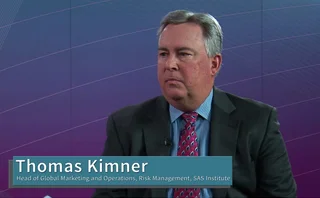
Bank writedowns - is the worst over?
The credit crisis that has roiled the financial markets has wiped out massive amounts of value from banks' balance sheets, resulting in crippling losses for some banks. Most recently, HSBC announced a 79% rise in loan impairment charges and credit risk provisions of $11.7 billion, and writedowns of $2.1 billion on its exposure to the credit crunch, which led it to shut down its US mortgage-backed securities business.
The losses at major banks around the world have mainly been due to the deteriorating quality of US subprime debt attached to residential mortgage backed securities (RMBSs) in collateralised debt obligations (CDOs) on banks' balance sheets, and high provisions for debt losses. Although in some cases these losses have been partially offset by value gains on banks’ own debt, these gains have been far from enough to fill the dents.
The banks most hit are those that have been very active in the US and European markets, with UBS, Citi, Merrill Lynch and HSBC reporting an aggregate loss of over $50 billion. Those that have highly diversified into emerging markets, such as Standard Chartered, which reported a comparitively low loss of $300 million, have been better able to weather the storm.
The problems have had a spiralling effect on institutions, with banks not only writing down direct exposures to the poor quality debt, but also having to make provisions for exposures to ailing counterparties, as in the case of Australia's ANZ Bank, which was forced to write down $200 million due to exposures to monolines.
The situation is further aggravated by growing uncertainty regarding the pricing of credit risk and the resilience of pricing models. Credit Suisse recently reported a $2.85 billion writedown due to "mis-markings and pricing errors in structured credit products" just days after it had announced a comparably moderate $1.2 billion in its 2007 earnings.
Many banks are expected to take additional writedowns against their portfolios, resulting from fair value mark-to-market valuations against non-US subprime positions, additional impairment against asset-backed securities (ABSs) and leveraged buyout (LBO) positions. Global writedowns have been estimated to reach up to $400 billion.
Donald Kohn, the vice-chairman of the US Federal Reserve, told the Senate's banking committee on March 4: "Looking ahead, bank holding companies will continue to face challenging market conditions and persistent pressure on earnings. More asset writedowns are likely as the market continues to adjust risk premiums and valuations change.”
This opinion was echoed by Philipp Hildebrand, the vice-chairman of Swiss National Bank. Speaking at a Northern Rock conference in London on March 3, Hildebrand said market conditions will deteriorate further. "We have seen no data suggesting that we are near an end to the decline. This is a unique situation, even including the Great Depression."
But rating agency Standard and Poor's (S&P) estimates that the worst is over because the global financial sector appears to have already disclosed the majority of valuation writedowns of subprime ABSs. S&P estimates that subprime writedowns could reach $285 billion, but are probably past the halfway mark. In its March 13 report, the rating agency said: “When we dissect the percentage of writedowns taken against various types of exposures, in our opinion the magnitude of some writedowns is greater than any reasonable estimate of ultimate losses."
Some market participants have speculated that, because accountants use the convention of conservatism, it is expected that there will be some write-ups on the assets that have been written down - but there has been no indication so far that this will happen in the next few months.
However, in spite of the writedowns, most banks reported a profit, primarily due to favourable performance in other parts of their businesses. Kohn pointed out: "Despite these adverse developments, bank holding companies still reported total net income exceeding $90 billion for the full year of 2007. In addition, the overall non-performing assets ratio remained below levels reached earlier in this decade.”
He added, however, that the earnings performance of the 50 largest US- based banks, which represent more than 75% of all assets at bank holding companies, had been subpar over the past two quarters. The banks generated overall losses of over $9 billion for the fourth quarter, with asset writedowns of more than $31 billion, and loan loss provisions exceeding loan charge-offs by $14 billion.
See also :
Monoline costs ANZ $200 million
Credit crisis losses could reach $400 billion
Subprime losses hit Q4 results
Standard Chartered reports $4 billlion profit
Only users who have a paid subscription or are part of a corporate subscription are able to print or copy content.
To access these options, along with all other subscription benefits, please contact info@risk.net or view our subscription options here: http://subscriptions.risk.net/subscribe
You are currently unable to print this content. Please contact info@risk.net to find out more.
You are currently unable to copy this content. Please contact info@risk.net to find out more.
Copyright Infopro Digital Limited. All rights reserved.
As outlined in our terms and conditions, https://www.infopro-digital.com/terms-and-conditions/subscriptions/ (point 2.4), printing is limited to a single copy.
If you would like to purchase additional rights please email info@risk.net
Copyright Infopro Digital Limited. All rights reserved.
You may share this content using our article tools. As outlined in our terms and conditions, https://www.infopro-digital.com/terms-and-conditions/subscriptions/ (clause 2.4), an Authorised User may only make one copy of the materials for their own personal use. You must also comply with the restrictions in clause 2.5.
If you would like to purchase additional rights please email info@risk.net
More on Infrastructure
Communications surveillance solutions 2024: market update
A report offering Chartis’ latest view of the vendor landscape for communications surveillance solutions
SIMONE, the AI that nearly took down a bank
An algorithm designed to create new structured products ran out of control last year with almost catastrophic consequences for a major bank, as our exclusive whistleblower account reveals
Revealed: where banks are (literally) warehousing their swaps
As derivatives notional grows, dealers experiment with novel storage solutions
E-trading takes hold for FX swaps – sort of
Bulk of trades are being executed over screen, but bolder changes have stalled
From DNA to DHA – Preparing for a new era of digital human augmentation
As technology increasingly permeates societies, cultures and everyday activities, its integration into people’s lives is having a profound impact on what is expected of people in the workplace. Deloitte examines this evolution of today’s workforce, the…
Risk and finance: Working more closely together
Video interview: Thomas Kimner, SAS
Video interview: Fabio Merlino, Intesa Sanpaolo
Fabio Merlino, head of retail and insurance risk discusses how the wealth management division of Intesa Sanpaolo upgraded its risk analytics capabilities with the algo system used by its proprietary traders
The changing face of Risk.net and our magazines
Extensive reader consultation has helped us reshape editorial teams and our site







